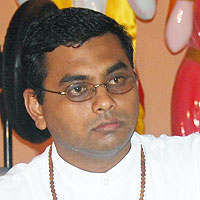From a satsang with Pt. Umadutt Maharaj, Spiritual Leader, SWAHA Bhakti Jyot Mandali
In Sanaatan Dharma, the disciplined mind is celebrated as the means by which the devotee can journey successfully through the world and advance spiritually to the highest state of Divine Consciousness. The highly mastered mind is personified by Shree Hanumanji, the Raamdoot, the devoted servant of Shree Raam.
In Sundar Kaand of the Ramaayan, Shree Hanumanji meets with Vibheeshan, the great devotee of Prabhu Shree Raam. At that point in time, Vibheeshan explained to Hanumanji that he had been performing sacrifices devotedly for all of his life with the hope that he would get the darshan (blessing) of Prabhu Shree Raam. On a daily basis he would call the name of Shree Raam, with the expectation that at the end of his life the Lord would be the captain that takes his boat to safety across the ocean of life. Yet, he was depressed at living in such a demonic environment where he himself was of the lineage of the asuras (demons), the brother of Ravan and Kumbhkaran; he doubted that he would ever receive the darshan of the Lord.
Hanuman Baba consoled him, explaining that the Lord is most affectionate to His devotees, the spiritual aspirants, who perform spiritual discipline to achieve that ultimate goal of Aham Brahmasmi, realising oneness with the Divine. The true devotee aspires to discover: who am I, what is the true purpose of life, and fulfils the promise to the Lord who has given us the most precious human form. Hanumanji explained that although He was a lower form of creation, a monkey, yet still He was the servant of the Lord who had entrusted Him with the sacred mission of finding Seeta Maataa. Definitely then, would Shree Raam bestow His darshan to the devoted Vibheeshan, who was blessed with a human form although of demonic lineage.
Vibheeshan’s eyes filled with tears when he heard this. Hanumanji continued to recall the glories and nature of the Lord. He then explained that it was his mission to discover the whereabouts of His Divine Mother, Seeta Maataa. Vibheeshan revealed that Seeta Maataa was being kept captive at the resplendent royal gardens of Ashok Vatika. Hanuman Baba was most delighted at heart on learning this.
It was too dangerous to assume His real form in this quest, as Seeta was guarded by many asuras, but the well-disciplined mind finds ways to achieve its goals. Hanumanji assumed a minute form, as He did when He first arrived in Lanka, through his power of anima siddhi, and went to Ashok Vatika to look for Her. There, He settled in one of the trees under which Seeta Maataa was sitting and mentally, He bowed to Her. She looked very frail and emaciated with her hair in one single braid, which was customary for a woman in mourning at that time. This symbolised separation from her husband and her despondent state of mind. All she did was constantly chant the name of Raam. Her eyes were fixed upon the ground just as her mind was fixed upon the feet of the Lord. Hanumanji was very unhappy when he saw the Divine Mother in such a state.
At that point Ravan arrived at the Ashok grove with a troop of demonesses and tried many strategies, from friendship and incentives to threats, to persuade Seeta Maataa to be his consort. He even promised to make his other wives Her servants if She would look at him even once. Then Seeta Maataa took a blade of grass and placed it between Herself and Ravan and addressed him through that blade of grass. She said, “Can the glow of a candlefly ever be enough to expand the lotus?”, meaning that the flower requires sunlight, represented by Shree Raam, as opposed to the glow of a candlefly, Ravan, the model of imperfection. This aggravated Ravan and he drew his sword to destroy Her. Seeta welcomed death but his Queen Mandodari intervened. Then Ravan ordered his hideous demonesses to constantly intimidate and frighten her everywhere in the grove so that she would be broken and give in to his demand. He gave Seeta an ultimatum: accept him within a month or She would be beheaded.
Hanuman Baba silently witnessed all this while concealed in the trees. He very wisely did not reveal Himself to them. Instead, He devised a safe plan to contact Seeta Maataa and assure Her that Shree Raam and his army were on their way to Lanka. Shree Hanuman represents the mind principle, the restrained mind that achieves its goal with firmness, constancy and full surrender to the Lord. One of the clearest depictions of this symbol of the disciplined mind is found in the representation of Panchavaktra Hanuman, the five-faced one. Each of the faces signifies different states of mind in the journey to perfection:
- Kshiptam: raving, wandering, restless, disturbed state of mind
- Mudham: dull, forgetful, lethargic
- Vikshiptam: oscillating, occasionally steady, easily distracted
- Ekaagram: one-pointed, tranquil, focused, concentrated
- Niruddham: restrained, controlled, regulated, highly mastered.
Shree Hanumanji represents the fifth state of mind, the disciplined mind, absorbed in the contemplation of Divinity, which earned Him success in all his endeavours in the divine cause of His Master, Shree Raam.



